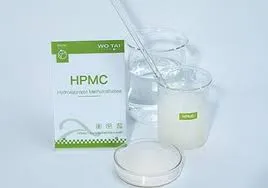
Dec . 06, 2024 06:38 Back to list
is hpmc soluble in water
Is HPMC Soluble in Water?
Hydroxypropyl methylcellulose (HPMC) is a widely used compound derived from cellulose, a natural polymer obtained from wood or cotton. Due to its unique properties, HPMC has gained prominence in various industries, including pharmaceuticals, food, construction, and cosmetics. One of the most critical aspects of HPMC is its solubility in water, which significantly affects its functionality and application.
Understanding HPMC and Its Structure
HPMC is created by chemically modifying cellulose through a series of reactions that introduce hydroxypropyl and methoxy groups. This modification enhances the solubility of cellulose in water, a characteristic that is essential for many of its applications. The degree of substitution, or the extent to which these groups are added to the cellulose backbone, determines the solubility and other physicochemical properties of HPMC.
The water-soluble nature of HPMC is attributed to the presence of these hydroxypropyl and methoxy groups, which promote interaction with water molecules. When HPMC is dispersed in water, it forms a gel-like solution, which can act as a thickening agent or an adhesive, depending on the concentration.
HPMC Solubility Characteristics
HPMC is generally soluble in cold and hot water, making it a versatile ingredient in various formulations. However, the solubility can vary based on several factors, including the molecular weight of the HPMC and the concentration used. Lower molecular weight grades of HPMC tend to dissolve more easily than higher molecular weight grades.
In practical applications, HPMC can be used to create solutions, gels, or films. For example, in pharmaceuticals, it serves as a binder in tablets, helping to ensure uniform distribution of active ingredients. In cosmetics, HPMC is utilized in lotions and creams for its thickening properties. In the food industry, it is employed as a stabilizer or emulsifier in sauces and dressings.
Factors Influencing Solubility
is hpmc soluble in water

While HPMC is soluble in water, certain factors can influence its solubility and performance in formulations. The temperature of the water plays a significant role; higher temperatures generally enhance the dissolution of HPMC. Additionally, the pH of the solution can impact its solubility. HPMC is stable over a wide pH range, but extreme conditions can affect its viscosity and solubility.
Another vital factor is the presence of other substances in the solution. For instance, electrolytes or other polymers may affect HPMC’s ability to dissolve. In concentrated solutions, HPMC can exhibit increased viscosity, leading to the formation of gels rather than a clear solution.
Applications of HPMC in Different Industries
The exceptional solubility of HPMC has made it indispensable across numerous sectors. In pharmaceuticals, it is used in controlled-release drug formulations, where its viscosity properties help regulate the release rate of active ingredients.
In the food industry, HPMC's solubility allows it to act as a bulking agent, improving texture while reducing fat content. It is commonly found in gluten-free products to enhance dough texture and moisture retention.
Construction materials also benefit from HPMC. It is included in mortar and tile adhesives to improve workability, adhesion, and water retention. Similarly, in cosmetic formulations, HPMC contributes to product stability and enhances texture without compromising skin feel.
Conclusion
In summary, HPMC is indeed soluble in water, which is a defining characteristic that underpins its myriad applications in multiple industries. Its solubility is influenced by various factors, including molecular weight, temperature, and the presence of other components in the solution. Understanding the solubility behavior of HPMC is crucial for formulators aiming to harness its properties effectively. As industries continue to innovate and develop new applications for HPMC, its role as a water-soluble polymer will undoubtedly remain significant. Whether in pharmaceuticals, food, construction, or cosmetics, HPMC's solubility in water enables it to deliver functionality and performance that meet diverse and evolving needs.
-
Versatile Hpmc Uses in Different Industries
NewsJun.19,2025
-
Redispersible Powder's Role in Enhancing Durability of Construction Products
NewsJun.19,2025
-
Hydroxyethyl Cellulose Applications Driving Green Industrial Processes
NewsJun.19,2025
-
Exploring Different Redispersible Polymer Powder
NewsJun.19,2025
-
Choosing the Right Mortar Bonding Agent
NewsJun.19,2025
-
Applications and Significance of China Hpmc in Modern Industries
NewsJun.19,2025







